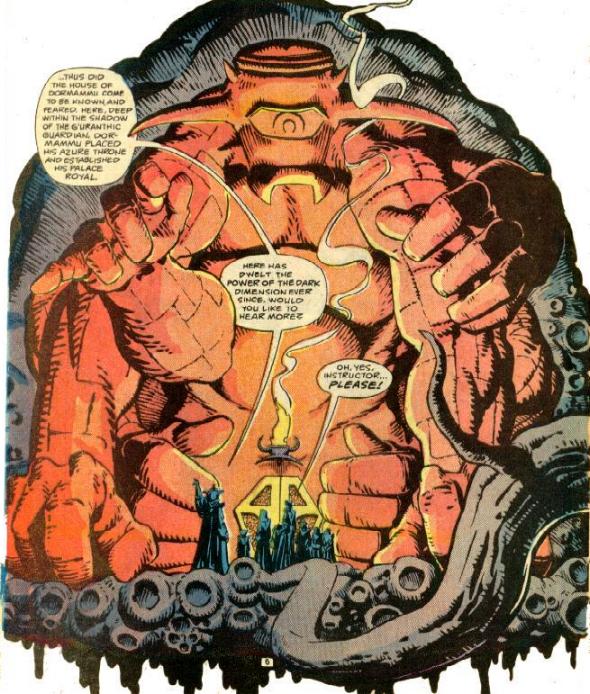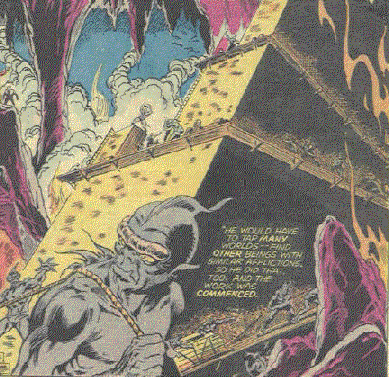I wrote this probably 6 years ago, and it was playtested two or three times, and a lot of fun. Enjoy!
Weird Dust Devils
An explictly magical hack of Dust Devils.
Dust Devils was created by +Matt Snyder is available through DriveThruRPG; you should really buy a copy, because it is fantastic.
First of all, let’s be clear. The existing rules of Dust Devils are really all you need to bring a weird, supernatural, or magical feel to your game. The limits on the Dealer’s power in setting up situations, and the Narrator’s power in describing resolution, are really consensual limit, and thus as long as everyone at the table agrees that weird stuff is in bounds, it is.
However, many people might wish to have a bit more system to help them integrate weirdness into a Dust Devil’s game. These rules are written to help those people out.
The Deck
The first major change in Weird Dust Devils is the deck of cards used; WDD is played with a tarot deck, not a normal playing card deck. Don't tell me you are surprised this uses a tarot deck, what else would it use?
Last night I stayed up late playing poker with Tarot cards. I got a full house and four people died. - Steven Wright
Characters
As Dust Devils, except –
- The existing scores are associated with the Tarot suits in the following way: Heart (Cups), Guts (Wands), Eye (Coins) and Hand (Swords).
- Characters have an extra Score called Power, and represents the characters overall familiarity with, capacity for, and resistance to, magical stuff.
- Characters have 16 points to spend on scores, not 13. NOTE: This isn’t quite right, because 13 is the perfect number for the other four scores. However, it seems to work in practice. Maybe just let people pick Power from 1-4, with some kind of trade off (ala the Devil)?
- Any character with a non-Zero Power score must also have a Weird, a single phrase description of the way in which the character interacts with, uses, or avoids magic. Examples: "Voodoo Houngan", "Aztec Mummy", "Jesuit Exorcist", "God of War", etc.
Conflict
Conflict occurs as described in Ch 2 of Dust Devils Revenged, except as follows.
- Any player may choose to add in their Power to the two Scores selected by the Dealer as relevant to the current conflict, thus giving them more cards in the initial deal.
- If a player uses their Power in a conflict, then they may only beat another hand with an Arcane hand. An Arcane hand is a hand where at least one of the five selected cards is a Trump. If they do not play an Arcane hand, then regardless of how good their hand is, they lose the conflict and their hand ranks lower than all other hands. In the event of two or more players in this situation, all are considered equal low hands. Note, if you draw a Straight Flush having used your Power, it's pretty clear evidence that the universe hates you.
- If a player uses their Power in a conflict, then the Narrator MUST use that Character’s Weird in some way to describe the conflict’s resolution.
- The harm caused by an Arcane hand is always distributed as desired by the player taking the Harm, regardless of the suits it contains.
- Only harm from an Arcane hand can be applied to a character’s Power score.
- The player who plays the LOWEST ranked card in their hand may, at their discretion, choose a Twist. They select from the available cards played in the conflict one card. The Narrator must use this card somehow in the narration of the conflict. It could be by using the name itself, some concept associated with the name, some element or aspect of the picture on the card, etc. There is no standard meaning to any card. Thus, the Twist is VERY dependent on the exact deck of cards you are using. Typically, this card will be a Trump, but in some decks all the cards may have evocative symbology that might be worth using.
NOTE: The combination of points 1 and 4 means that, while using your Power will give you more cards, it also means that your opponent can spread the harm around more freely if they lose. This seems like a good trade off to me.
Hands
Definitions
- Trump – one of 21 cards, numbered 1 to 21, often called the Major Arcana in tarot decks designed for divinatory or occult purposes.
- Non-Trumps – One of the 56 cards, ranked from Ace (A), then 2 to 10, then Page (P), Knight (N), Queen (Q), King (K), in four suits (Swords, Cups, Clubs, Coins), that are not Trumps.
- Run - A set of three or more Trumps in numerical order; a set of two Trumps in order do NOT form a run.
- Rank Order – All Trumps, rank above all non-Trumps. Among the Trumps, the higher number ranks above the lower. The suits of non-Trumps rank as follows, highest to lowest: Swords, Cups, Wands, Coins. Within a suit, non-Trumps are ordered, highest to lowest: A (high), K, Q, N, P, 10, 9, 8, 7, 6, 5, 4, 3, 2, A (low).
During conflict, the following are the possible hands that can be constructed, in order of precedence. The ones marked in blue are always Arcane hands; that is, they require Trumps. The ones marked in green are Mundane hands; that is, they cannot contain any Trumps. Other hands can be either Arcane or Mundane depending on the extra cards included in them. Note that hands of higher precedence can incorporate lower precedence hands; always consider a hand to be of the highest possible precedence it can be. This order of precedence is based on the probability of getting that hand with five randomly drawn cards.
Hand
|
Composition
|
Tie-breaking
rule
|
Harm
|
Ordered
Five
|
Any
five Trumps in a run.
|
Highest
ranked Trump in hand.
|
5
|
Straight
Flush
|
Any
five non-Trumps in sequence of rank order, all in the same suit.
|
Highest
ranked non-Trump in hand.
|
5
|
Four
of a Kind
|
Any
four non-Trumps of the same rank, plus any other card.
|
Highest
ranked non-Trump of the four matched Plains.
|
4
|
Ordered
Four
|
Any
four Trumps, in a run, plus any other card.
|
Highest
ranked Trump in the run.
|
4
|
Balanced
Three
|
Any
three Trumps in a run, plus two Plains of the same rank.
|
Highest
ranked Trump in the run.
|
4
|
Full
House
|
Any
three non-Trumps of the same rank, plus any two non-Trumps of a different
rank.
|
Highest
ranked non-Trump in the three matched non-Trumps.
|
4
|
Flush
|
Any
five non-Trumps in the same suit.
|
Highest
ranked non-Trump in the hand, followed by second ranked, and so on,
with the Higher ranked Suit winning if all non-Trumps are of identical
rank.
|
3
|
Straight
|
Any
five non-Trumps in sequence of rank order.
|
Highest
ranked non-Trump in the hand. Higher ranked Suit of highest ranked
non-Trump if they are identical.
|
3
|
Chaotic
Five
|
Any
five Trumps that form no run.
|
Highest
ranked Trump in the hand.
|
3
|
Ordered
Three
|
Any
three Trumps that form a run, plus two other cards.
|
Highest
ranked Trump in the hand.
|
2
|
Three
of a Kind
|
Any
three non-Trumps of the same rank, plus any two other cards.
|
Highest
ranked non-Trumps in the three of matched Plains.
|
2
|
Two
Pair
|
Any
two non-Trumps of the same rank, plus any two non-Trumps of the same rank
different from the first set, plus any other card.
|
Highest
ranked non-Trump in the highest ranked pair, followed by highest
ranked non-Trump in the second pair, followed by the rank of the fifth
card.
|
2
|
Chaotic
Four
|
Any
four Trumps that form no run, plus any one non-Trump.
|
Highest
ranked Trump.
|
2
|
Chaotic
Three
|
Any
three Trumps that form no run, plus any two non-Trumps.
|
Highest
ranked Trump.
|
1
|
Pair
|
Any
two non-Trumps of the same rank, plus three other cards.
|
Highest
ranked plain in the pair, followed by ranks of the remaining
cards.
|
1
|
High
Card
|
Any
hand that cannot be formed into a higher precedence hand.
|
Highest
ranked card.
|
1
|
The Fool is always wild, and has no value of its own; it is neither Trump nor non-Trump in and of itself. The Wheel of Fortune is wild but can only count as another Trump, not as a non-Trump. In any case where a hand with a wild card is being compared to an otherwise identical hand without a wild card, the hand without the wild card wins. In any case where two hands are identical, and one has a Fool and the other a Wheel of Fortune, the hand with the Wheel of Fortune wins.
Tarot Decks
Your basic
Rider-Waite deck from your local bookstore will do, but sort of sucks for a number of reasons for a Weird West theme: the imagery is off, the cards are difficult to read when in a hand, etc. You can probably do better if you are willing to shop around.
The Tarot decks from Europe designed for actually playing games, instead of divination, would be very good for Weird Dust Devils. For example,
this is a picture of some cards from an Austrian deck. Also, I think any of these
Piatnik Tarock decks would work. Be careful, though, some of these decks have different numbers of cards because they are designed for
very specific games. The order of precedence, above, is based on a 78 card deck (21 Trumps, Fool, 56 non-Trump). You can certainly play with a different (usually smaller) deck with trumps, but this will make the order of precedence of the hands go squirrelly.
The suits on Tarot decks can be all over the map, depending on exactly which deck you use. See
Wikipedia's article on suits for more information. Just make sure you clearly map your deck’s suits to the four Attributes (Heart, Guts, Hand, Eye) and you will be fine.
There are some cool old school historical reproductions of decks from the 1800’s that seem to me to be a good match for a Weird West themed game, see…
Here are some other decks that aren’t historical, but might be cool…





.PNG)

_Mighty_Avengers_Vol_3_2.jpg)